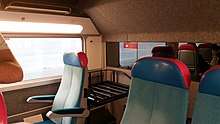Ouigo
 | |
| Overview | |
|---|---|
| Franchise(s) | Wholly owned subsidiary of SNCF |
| Main station(s) |
Marne-la-Vallée, Lyon Saint-Exupéry, Montpellier, Marseille Tourcoing, Rennes, Nantes |
| Other station(s) | Lyon Part-Dieu, Lyon Perrache, Valence, Nîmes, Avignon, Aix en Provence, TGV Haute-Picardie, Aéroport Charles de Gaulle, Massy TGV, Le Mans and Angers-Saint-Laud. |
| Stations called at | 18 |
| Parent company | SNCF |
| Website |
www |
Ouigo services | ||||||||||||||||||||||||||||||||||||||||||||||||||||||||||||||||||||||||||||||||||||||||||||||||||||||||||||||||||||||||||||||||||||||||||||||||||||||||||||||||||||||||||||
|---|---|---|---|---|---|---|---|---|---|---|---|---|---|---|---|---|---|---|---|---|---|---|---|---|---|---|---|---|---|---|---|---|---|---|---|---|---|---|---|---|---|---|---|---|---|---|---|---|---|---|---|---|---|---|---|---|---|---|---|---|---|---|---|---|---|---|---|---|---|---|---|---|---|---|---|---|---|---|---|---|---|---|---|---|---|---|---|---|---|---|---|---|---|---|---|---|---|---|---|---|---|---|---|---|---|---|---|---|---|---|---|---|---|---|---|---|---|---|---|---|---|---|---|---|---|---|---|---|---|---|---|---|---|---|---|---|---|---|---|---|---|---|---|---|---|---|---|---|---|---|---|---|---|---|---|---|---|---|---|---|---|---|---|---|---|---|---|---|---|---|---|---|
| ||||||||||||||||||||||||||||||||||||||||||||||||||||||||||||||||||||||||||||||||||||||||||||||||||||||||||||||||||||||||||||||||||||||||||||||||||||||||||||||||||||||||||||
Ouigo (French pronunciation: [wiˈɡo]) is a French low-cost high-speed train service headquartered in Marne-la-Vallée offering long-distance services on core routes of the French rail network, albeit mostly between secondary stations. It is an independent subsidiary of the French national rail company SNCF and also utilizes some of their TGV trainsets.
Development
The service was announced by the head of SNCF, Guillaume Pepy on 19 February 2013,[1] and it was launched on 2 April of the same year. Unlike Europe's relatively liberalized airline market (open skies), high speed railways in France (and generally in Europe) are a monopoly owned and operated by the government. However ongoing talks about high speed railways liberalization, targeted for as early as December 2019, and competition from low-cost airlines, as well as the anticipation of a deregulation of the intercity bus market as had happened in Germany the previous year and would occur shortly thereafter in France, led to the creation in 2013 of the Ouigo service.[2][3][4]
In the few months between announcement to the commencing of journeys, Ouigo has sold 200,000 tickets and its website has been visited by over 2 million times.[5] On 12 September 2013, SNCF announced that a milestone of sales of over one million tickets have been sold. They also mentioned that of those tickets being sold, 35% were sold for less than €35.[6] On 1 April 2014, SNCF announced that Ouigo in the last year has sold over 2.5 million tickets, of which 80% were 25 euros or less. It also announced that its website has had traffic of 10 million visits.[7]
On 3 September 2015, SNCF announced new Ouigo services for start of first quarter of 2016, linking Tourcoing (near Lille) with Lyon-Part-Dieu, Nantes and Rennes, with intermediate stops in TGV Haute-Picardie, Aéroport Charles de Gaulle, Massy TGV, Le Mans and Angers-Saint-Laud. Tickets would be available from the 17 November 2015 [8][9] It was later announced that Ouigo would be serving it new destinations on the 13 December 2015.[10]
In March 2016, one of SNCF's international companies, Thalys, launched a similar low-cost international service between Paris & Brussels called IZY on 3 April 2016.
In an interview with CNN's Business Traveller, Guillaume Pepy hopes that if Ouigo is successful, he hopes to expand and in the future provide services beyond France to Brussels, Amsterdam and London.[11] SNCF has said it hopes to also offer services to south west by 2017, principally Bordeaux.[12]
 | |
| Source Les Echos[13] | |
Concept
The idea of service is based on low-cost airlines such as Ryanair and EasyJet; accordingly, Ouigo uses the following practices:
- Tickets can only be bought on-line through a dedicated website or mobile app, not from ticket machines, ticket counters or through the regular SNCF website. Since October 2013, customers can also book tickets via the non-affiliated booking agent Captain Train.[14] They must be purchased at least 4 hours in advance of the journey. Four days before passengers' travel, they receive an e-mail of the ticket which they may print out at home, or they may use the mobile app to access the e-ticket.
- Ouigo uses modified double-decker TGV Duplex trains, which are single 2nd class made up of either 2x2 or 3x1 abreast, and lack a buffet car. This leads to the train carrying up 1200 passengers, which is 20% more passengers than regular TGV Duplex trains.
- Similar to some low cost airlines, whilst a piece of hand luggage (maximum size, 35 cm×55 cm×25 cm) is allowed free of charge, larger bags must be paid for.
- Like the low-cost carriers' use of secondary airports like Paris-Beauvais instead of major airports like Paris-Charles de Gaulle, the company uses some non-major railway stations like Marne-la-Vallée for Paris instead of Paris-Gare de Lyon, Tourcoing for Lille and Lyon Saint-Exupéry for Lyon. The reason for this is that like the low-cost carriers which uses the secondary airports due to lower fees, Ouigo uses the outgoing stations due to lower fees imposed by the rail network company, SNCF Réseau.
- The trains carry fewer staff, which like on low-cost airliners are tasked as well to do basic maintenance of the train as well as serving passengers.
- The company sweats its assets by using the trains for up to 13 hours a day, compared to just seven on a regular TGV.
- Like some low-cost air carriers, the only way customers can contact the company is via their website. There is no customer service phone number or e-mail address.[15]
Fare structure
Adult fares can vary from as little as €10 to a maximum of €115 per journey depending on the time of the journey and how far it is booked in advance. Supplementary fees are as follows:
- Children that are 11 or under, a flat fee of €5 is charged no matter the journey.
- Baggage (per piece) is €5 if booked at the time of booking, €10 prior to travelling on-line, or €20 if purchased at the station immediately prior to travel.
- Pets can be taken on board, however provided that they are under six kilos and they are in the carry case as part of the hand luggage they travel free. If not, they are charged a fee of €40 per animal, or €30 if they are booked at the same time as owner.
- Seats next to plug sockets can be reserved for a supplementary fee of €2 per person.
Stations

_(10072166004).jpg)
Ouigo offers trains stopping at a number of stations. Unlike standard TGV services, and in order to offer lower fares, the company uses non-major stations for main destinations such as Paris or Lyon. The stations served are: on the Paris to the south east route are Marne-la-Vallée, Lyon Saint-Exupéry, Lyon Part-Dieu, Lyon Perrache, Valence, Nîmes, Montpellier, Avignon, Aix en Provence and Marseille, The north-east to the north-west route are Tourcoing (near Lille) Nantes, Rennes, TGV Haute-Picardie, Aéroport Charles de Gaulle, Massy TGV, Le Mans and Angers-Saint-Laud..
| Service from | to | Services per Week |
|---|---|---|
| Marne-la-Vallée – Chessy | Marseille Saint-Charles | 14 |
| Marne-la-Vallée – Chessy | Montpellier Saint-Roch | 8 |
| Marne-la-Vallée – Chessy | Lyon-Part-Dieu | 6 |
| Marseille Saint-Charles | Marne-la-Vallée – Chessy | 17 |
| Marseille Saint-Charles | Lyon-Perrache | 1 |
| Montpellier Saint-Roch | Marne-la-Vallée – Chessy | 7 |
| Montpellier Saint-Roch | Lyon-Perrache | 1 |
| Lyon-Perrache | Marne-la-Vallée – Chessy | 4 |
| Lyon-Perrache | Marseille Saint-Charles | 4 |
| Lyon-Perrache | Tourcoing | 7 |
| Lyon-Perrache | Nantes | 1 |
| Tourcoing | Nantes | 6 |
| Tourcoing | Rennes | 7 |
| Tourcoing | Lyon-Part-Dieu | 7 |
| Rennes | Lyon-Part-Dieu | 1 |
| Rennes | Tourcoing | 6 |
| Nantes | Tourcoing | 7 |
Reception
In the first few months, Ouigo sent passengers a short questionnaire after each trip, and has had a 20% response rate. The response surprised the company with half of passengers saying they came from the regular TGV service, short of the 70% that the company envisaged, while a quarter of respondents said they would have not made the trip without Ouigo. The survey also reported that about 90% of passengers would recommend Ouigo to a friend or family member.[16]
Commentators such as the travel writer Simon Calder have said that it is a third-class train service, and rail writer Mark Smith called it a rail service for flyers.[17] The head of the rail division of the left wing trade union CGT Bruno Charrier, said that it is a train created for the poor.[18] Initially non-French customers had issues trying to book tickets, as the service requested from its users a French mobile phone number and postcode. However, since October 2013 to website has been changed to allow foreign customers to book tickets.The phone number is needed to provide information by text message for passengers in case of any issues.[19]
Among English-speaking high-speed rail advocates, opinion is divided. The British HSR lobbying group, Greengauge 21 is keen on the idea of a low-cost high-speed rail service, and with it the possibility of employing underused stations such as Stratford International and Ebbsfleet International.[20] The California High Speed Rail Blog finds the concept "troubling", and laments the loss of the dining car, the reduction in on-train service and the increased workload of the train staff.[21]
References
- ↑ IOVENE, Franck. "La SNCF présente ses TGV low cost Ouigo à la conquête de nouveaux clients". AFP. Google. Retrieved 11 April 2013.
- ↑ http://www.railpro.co.uk/magazine/?idArticles=1503
- ↑ http://www.smartplanet.com/blog/global-observer/in-paris-high-speed-trains-go-low-cost/10291
- ↑ "Archived copy". Archived from the original on 3 April 2013. Retrieved 3 April 2013.
- ↑ "Ouigo low-cost TGV service off to a good start". International Railway Journal. 3 April 2013. Retrieved 11 April 2013.
- ↑ Briginshaw, David. "First 1 million Ouigo tickets sold". International Railway Journal. Retrieved 12 September 2013.
- ↑ "Le TGV low cost Ouigo a transporté 2,5 millions de passagers en un an". MobiliCités. 1 April 2014. Archived from the original on 31 October 2014. Retrieved 4 April 2015.
- ↑ "DITES #OUI AUX BUS ET AUX TGV ROSES ET BLEUS EN NORD-PAS-DE-CALAIS !". ImagineTGV. Retrieved 3 September 2015.
- ↑ OuiGo et OuiBus : nouvelles destinations Archived 24 September 2015 at the Wayback Machine.
- ↑ "Ouverture des ventes d'hiver 2015". Ouigo. Ouigo. Retrieved 3 November 2015.
- ↑ "Part 1: Europe's high speed rail future". CNN Business Traveller. Retrieved 12 April 2013.
- ↑ "Ouigo à la conquête de l'Ouest". Mobilicités. AFP. Archived from the original on 30 May 2014. Retrieved 24 December 2015.
- ↑ https://www.lesechos.fr/industrie-services/tourisme-transport/0302222287935-la-sncf-celebre-les-5-ans-de-ouigo-piece-maitresse-du-renouveau-du-tgv-2203769.php
- ↑ "Carl". "Travel Cheaper by Train in France with OUIGO". Captaine Train Blog. Retrieved 26 October 2013.
- ↑ "contact - Vous avez des questions ? Nous vous répondons". Ouigo. Retrieved 11 April 2013.
- ↑ Briginshaw, David (2013-06-04). "Ouigo leads the way in low-fare high-speed rail". International Railway Journal. Retrieved 21 June 2013.
- ↑ Calder, Simon (23 March 2013). "Ouigo: welcome to troisième classe". The Independent. London.
- ↑ "Quand la CGT dénonce le TGV low cost Ouigo de la SNCF". Challengers. dailymotion.com.
- ↑ "Ouigo Trains". tripadviser.co.uk.
- ↑ "Why cheap and cheerful makes good business sense". Greengauge 21. Retrieved 13 April 2013.
- ↑ Cruickshank, Robert. "We Go More Cheaply Across France on High Speed Rail". California High Speed Rail Blog. Retrieved 13 April 2013.
External links
![]()